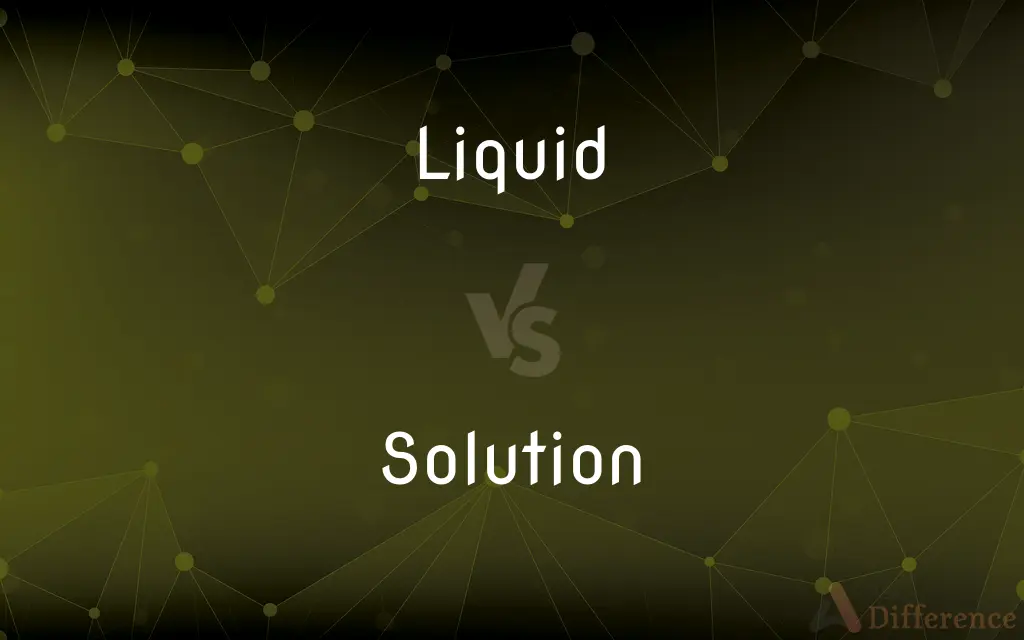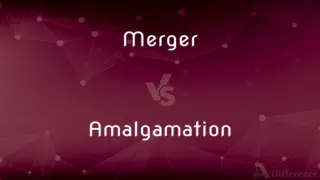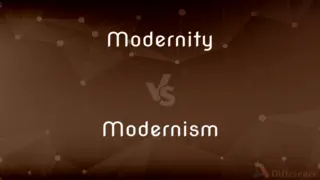Liquid vs. Solution — What's the Difference?
Edited by Tayyaba Rehman — By Maham Liaqat — Updated on April 18, 2024
Liquid is a state of matter characterized by fluidity and fixed volume, whereas a solution is a homogeneous mixture of two or more substances, often liquid.

Difference Between Liquid and Solution
Table of Contents
ADVERTISEMENT
Key Differences
Liquids are one of the fundamental states of matter with properties like fluidity and the ability to conform to the shape of their container while maintaining a constant volume. In contrast, a solution is a specific type of liquid, where one substance (the solute) is completely dissolved into another (the solvent) to form a uniform mixture.
The fluid nature of liquids allows them to flow and take the shape of their container, whereas solutions exhibit these characteristics but also include the dissolved substances, which can affect properties such as boiling point and viscosity.
A pure liquid, such as distilled water, has consistent properties throughout its volume. On the other hand, solutions vary based on the concentration and nature of the solute and solvent involved, impacting attributes like taste, color, and conductivity.
Liquids can exist alone as pure substances or as mixtures, but they don't necessarily involve a solvation process. Solutions always involve the interaction of two or more substances where the solute particles are uniformly distributed within the solvent.
Understanding the behavior of liquids is crucial in fields like hydrodynamics and material science. Solutions, however, are studied extensively in chemistry and biology, where the solute-solvent interactions are essential for processes like chemical reactions and drug delivery.
ADVERTISEMENT
Comparison Chart
Definition
A state of matter with fixed volume and adaptability to container shape.
A homogeneous mixture of two or more substances.
Composition
Can be a pure substance or a mixture.
Always a mixture of solute and solvent.
Properties
Consistent throughout if pure.
Altered by the type and concentration of solute.
Dependence on Temperature
Properties such as viscosity and density are temperature-dependent.
Solubility of solutes is also temperature-dependent, often increasing with heat.
Applications
Broad, from everyday fluids to industrial applications.
Crucial in chemical solutions, pharmaceuticals, and biological systems.
Compare with Definitions
Liquid
Not compressible like gases.
Hydraulic systems rely on the incompressibility of liquids.
Solution
Used in various scientific and industrial applications.
Solutions are essential in medicinal formulations.
Liquid
A state of matter that flows freely.
Water and mercury are typical liquids at room temperature.
Solution
Can vary in concentration.
A concentrated solution of bleach in water is stronger than a dilute one.
Liquid
Viscosity and surface tension are key properties.
Syrup flows slower than water due to higher viscosity.
Solution
Physical properties differ from those of the solvent alone.
Adding salt to water raises its boiling point.
Liquid
Can form mixtures or solutions.
Oil and water form a mixture, not dissolving well together.
Solution
Consists of a solute dissolved in a solvent.
In a sugar solution, sugar is the solute while water is the solvent.
Liquid
Maintains a fixed volume under constant conditions.
Water in a glass retains its volume despite the glass's shape.
Solution
A homogeneous mixture of two or more substances.
Saltwater is a solution of salt in water.
Liquid
A liquid is a nearly incompressible fluid that conforms to the shape of its container but retains a (nearly) constant volume independent of pressure. As such, it is one of the four fundamental states of matter (the others being solid, gas, and plasma), and is the only state with a definite volume but no fixed shape.
Solution
A method or process of dealing with a problem
Sought a solution to falling enrollments.
Liquid
The state of matter in which a substance exhibits a characteristic readiness to flow and little or no tendency to disperse, and is amorphous but has a fixed volume and is difficult to compress.
Solution
The answer to a problem or the explanation for something
The solution to the mystery.
Liquid
Matter or a specific body of matter in this state.
Solution
A homogeneous mixture of two or more substances, which may be solids, liquids, gases, or a combination of these.
Liquid
(Linguistics) A consonant articulated without friction and capable of being prolonged like a vowel, such as English l and r.
Solution
The process of forming such a mixture.
Liquid
Of or being a liquid.
Solution
The state of being dissolved
Nitrogen that is in solution in the ocean.
Liquid
Melted by heating
Liquid wax.
Solution
(Archaic) The act of separating or breaking up; dissolution.
Liquid
Condensed by cooling
Liquid oxygen.
Solution
A homogeneous mixture, which may be liquid, gas or solid, formed by dissolving one or more substances.
Liquid
Flowing readily; fluid
Added milk to make the batter more liquid.
Solution
An act, plan or other means, used or proposed, to solve a problem.
Liquid
Having a flowing quality without harshness or abrupt breaks
Liquid prose.
The liquid movements of a ballet dancer.
Solution
An answer to a problem.
Liquid
(Linguistics) Articulated without friction and capable of being prolonged like a vowel.
Solution
(marketing) A product, service or suite thereof, especially software.
Liquid
Clear and shining
The liquid brown eyes of a spaniel.
Solution
Satisfaction of a claim or debt.
Liquid
Existing as or readily convertible into cash
Liquid assets.
Solution
The act of dissolving, especially of a solid by a fluid; dissolution.
Liquid
A substance that is flowing, and keeping no shape, such as water; a substance of which the molecules, while not tending to separate from one another like those of a gas, readily change their relative position, and which therefore retains no definite shape, except that determined by the containing receptacle; an inelastic fluid.
A liquid can freeze to become a solid or evaporate into a gas.
Solution
The crisis of a disease.
Liquid
(phonetics) Any of a class of consonant sounds that includes l and r.
Solution
To treat with a solution.
Liquid
Flowing freely like water; fluid; not solid and not gaseous; composed of particles that move freely among each other on the slightest pressure.
Liquid nitrogen
Solution
The act of separating the parts of any body, or the condition of undergoing a separation of parts; disruption; breach.
In all bodies there is an appetite of union and evitation of solution of continuity.
Liquid
Easily sold or disposed of without losing value.
Solution
The act of solving, or the state of being solved; the disentanglement of any intricate problem or difficult question; explanation; clearing up; - used especially in mathematics, either of the process of solving an equation or problem, or the result of the process.
Liquid
Having sufficient trading activity to make buying or selling easy.
Solution
The state of being dissolved or disintegrated; resolution; disintegration.
It is unquestionably an enterprise of more promise to assail the nations in their hour of faintness and solution, than at a time when magnificent and seductive systems of worship were at their height of energy and splendor.
Liquid
Flowing or sounding smoothly or without abrupt transitions or harsh tones.
A liquid melody
Solution
The act or process by which a body (whether solid, liquid, or gaseous) is absorbed into a liquid, and, remaining or becoming fluid, is diffused throughout the solvent; also, the product resulting from such absorption.
Liquid
(phonology) Belonging to a class of consonants comprised of the laterals and the rhotics, which in many languages behave similarly.
Solution
Release; deliverance; discharge.
Liquid
Fluid and transparent.
The liquid air
Solution
The termination of a disease; resolution.
Liquid
Flowing freely like water; fluid; not solid.
Yea, though he go upon the plane and liquid water which will receive no step.
Solution
A homogeneous mixture of two or more substances; frequently (but not necessarily) a liquid solution;
He used a solution of peroxide and water
Liquid
Being in such a state that the component molecules move freely among themselves, but have a definite volume changing only slightly with changes of pressure, and do not tend to separate from each other as the particles of gases and vapors do when the volume of the container is increased; neither solid nor gaseous; as, liquid mercury, in distinction from mercury solidified or in a state of vapor.
Solution
A statement that solves a problem or explains how to solve the problem;
They were trying to find a peaceful solution
The answers were in the back of the book
He computed the result to four decimal places
Liquid
Flowing or sounding smoothly or without abrupt transitions or harsh tones.
Solution
A method for solving a problem;
The easy solution is to look it up in the handbook
Liquid
Pronounced without any jar or harshness; smooth; as, l and r are liquid letters.
Solution
The set of values that give a true statement when substituted into an equation
Liquid
Fluid and transparent; as, the liquid air.
Solution
The successful action of solving a problem;
The solution took three hours
Liquid
Clear; definite in terms or amount.
Liquid
In cash or readily convertible into cash without loss of principle; - said of assets, such as bank accounts, or short-term bonds tradable on a major stock exchange.
Liquid
A substance whose parts change their relative position on the slightest pressure, and therefore retain no definite form; any substance in the state of liquidity; a fluid that is not gaseous and has a definite volume independent, of the container in which it is held. Liquids have a fixed volume at any given pressure, but their shape is determined by the container in which it is contained. Liquids, in contrast to gases, cannot expand indefinitely to fill an expanding container, and are only slightly compressible by application of pressure.
Liquid
A letter which has a smooth, flowing sound, or which flows smoothly after a mute; as, l and r, in bla, bra. M and n also are called liquids.
Liquid
A substance that is liquid at room temperature and pressure
Liquid
The state in which a substance exhibits a characteristic readiness to flow with little or no tendency to disperse and relatively high incompressibility
Liquid
A substance in the fluid state of matter having no fixed shape but a fixed volume
Liquid
A frictionless non-nasal continuant (especially `l' and `r')
Liquid
Existing as or having characteristics of a liquid; especially tending to flow;
Water and milk and blood are liquid substances
Ice is water in the solid state
Liquid
Filled or brimming with tears;
Swimming eyes
Watery eyes
Sorrow made the eyes of many grow liquid
Liquid
Clear and bright;
The liquid air of a spring morning
Eyes shining with a liquid luster
Limpid blue eyes
Liquid
Changed from a solid to a liquid state;
Rivers filled to overflowing by melted snow
Liquid
Smooth and flowing in quality; entirely free of harshness;
The liquid song of a robin
Liquid
Yielding; lacking any hint of hardness;
The liquid stillness of the night enveloping him
The liquid brown eyes of a spaniel
Liquid
Smooth and unconstrained in movement;
A long, smooth stride
The fluid motion of a cat
The liquid grace of a ballerina
Liquid prose
Liquid
In cash or easily convertible to cash;
Liquid (or fluid) assets
Common Curiosities
How does temperature affect liquids and solutions?
Temperature can change the viscosity of liquids and the solubility of solutes in solutions.
Can all liquids form solutions?
Not all liquids can form solutions, as some liquids are immiscible, meaning they do not mix to form a solution.
Are gases also considered liquids?
No, gases are a different state of matter; they have neither fixed volume nor fixed shape.
How do the properties of a solution compare to those of its solvent?
The properties of a solution, such as boiling point and conductivity, can differ significantly from those of the pure solvent due to the presence of the solute.
What is a liquid?
A liquid is a state of matter that flows, has fixed volume, and adapts to the shape of its container.
What is a solution?
A solution is a homogeneous mixture of two or more substances where the solute is uniformly distributed within the solvent.
What is the difference between a solution and a mixture?
Solutions are homogeneous mixtures with uniform composition throughout, whereas mixtures can be homogeneous or heterogeneous and do not require solute dissolution.
Can a solution revert back to its original components easily?
Depending on the type of solution, some can be separated into their components through processes like evaporation or distillation, while others are more complex.
What happens if the solute’s concentration exceeds its solubility?
Exceeding solubility leads to the formation of a saturated solution, and any additional solute may precipitate or remain undissolved.
Why are solutions important in industries?
Solutions are crucial in industries for processes such as manufacturing drugs, cleaning agents, and in food production.
What makes a good solvent for a solution?
A good solvent efficiently dissolves the solute and is chemically stable and non-reactive with the solute under desired conditions.
Why is understanding solutions important in chemistry?
Understanding solutions is key to predicting and controlling reactions, formulating compounds, and analyzing substances in chemistry.
What role does pressure play in the properties of liquids?
Pressure can influence the boiling point and freezing point of liquids but generally has less effect on liquids than on gases.
How does solubility relate to making a solution?
Solubility is a measure of how much solute can be dissolved by a solvent at a given temperature and pressure to form a solution.
What are examples of everyday solutions?
Common examples include saltwater, vinegar, and air (a solution of gases).
Share Your Discovery

Previous Comparison
Merger vs. Amalgamation
Next Comparison
Modernity vs. ModernismAuthor Spotlight
Written by
Maham LiaqatEdited by
Tayyaba RehmanTayyaba Rehman is a distinguished writer, currently serving as a primary contributor to askdifference.com. As a researcher in semantics and etymology, Tayyaba's passion for the complexity of languages and their distinctions has found a perfect home on the platform. Tayyaba delves into the intricacies of language, distinguishing between commonly confused words and phrases, thereby providing clarity for readers worldwide.














































